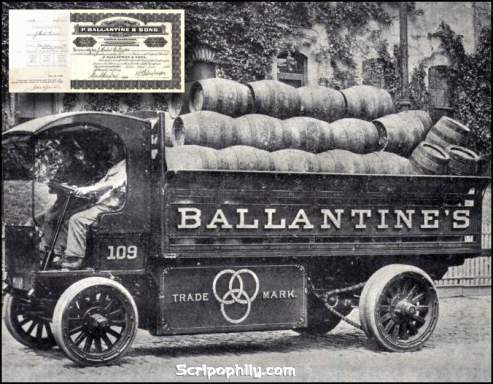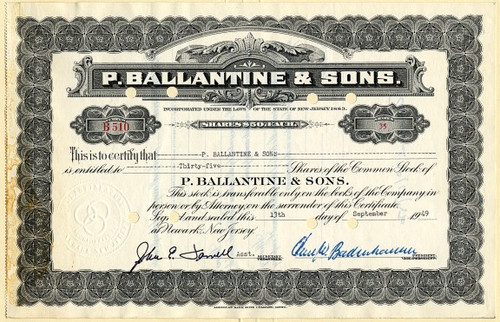Beautiful unissued certificate from P. Ballantine & Sons printed around 1920. This historic document was printed by the American Bank Note Company and has an ornate border around it with a vignette of the Company's name. 
Certificate Vignette 
The Ballantine Brewing Company was once the 4th largest brewer in the United States. Founded in 1840 in Newark by Peter Ballantine, a native of Scotland. Originally called the Patterson & Ballantine Brewing Company, Ballantine and his partner rented an old brewing site which dated back to 1805. In about 1850 Ballantine bought out his partner and purchased land near the Passaic River to brew his popular ale. His three sons joined the business and in 1857 the company was renamed P. Ballantine and Sons, a name it kept until it closed almost 115 years later. By about 1879 it was the sixth largest brewery in the US, almost twice as large as the current giant, Anheuser-Busch. The famous Ballantine three ring symbol ("Purity, Body, Flavor") was inspired by the wet rings left on a table as Peter Ballantine consumed his beer and was first used by the brewery in 1879. This same year Ballantine purchased the Schalk brewery to produce lager beer. The increase in immigrants from central Europe meant America's taste was moving away from the traditional English type ales. By the 1880s, Ballantine Brewing plants covered 12 acres and was the sixth largest brewer in America. In late 1882, Ballantine's oldest son Peter H. suddenly took ill after a trip to Europe and died (a pic of his grave is below). His father, active in the business until he died, quickly followed him in January of 1883 at the age of 91. The running of the brewery was passed to John H. Ballantine, and later Robert F. Ballantine. John Herbert's oldest son John, got into a fight with his family about saving a batch of beer, and left the family business. He went on to found the Neptune Meter Co. After the death of the last son Robert, the company was headed up by by George Frelinghuysen. Following the lifting of the Volstead Act, German brewing equipment salesman Carl Badenhausen and his brother Otto approached Ballantine to purchase the brewery. During the "dry" years, Badenhausen had sold equipment to breweries in South America. The management of Ballantine did not want to return to brewing as so many in-house skills had been lost during Prohibition. The brothers purchased the brewery and imported a brewmaster, Archibald MacKenchnie, from Scotland. The Ballantine beers and ales quickly returned to their original popularity in the greater New York City area. During WWII Ballantine sponsored "Uncle Miltie" Berle on the radio as well as the New York Yankees in the 1940s and 50s. Ballantine were also one of the first breweries to sell canned beer in six packs for home consumption. Prior to Prohibition, virtually all beer was sold in kegs or individual bottles. In 1943, Ballantine acquired the Christian Feiganspan Brewery also of Newark and ran this as a second brewery until 1948, when it was closed. Their brands included P.O.N. (Pride of Newark) and Munich. Ballantine had a close association with local sports. N.Y. Yankee announcer Mel Allen's called every Yankee home run a "Ballantine Blast" on his radio and later television coverage. By 1950 Ballantine was the third largest brewer in America, surpassed only by Schlitz and A-B, brewing 4.3 million barrels. Ballantine also later owned the Boston Celtics basketball team for a time. During the 1960's, the company's sales began to decline. Ballantine Brewing had now fallen to sixth place and they were the only single plant brewery remaining in the top ten. An attempt was made to "modernize" the formula and flavor, as many other national brewers had already done, but it failed to slow the rapid decline in sales. New TV ads were tried as well, including one featuring Mel Brooks as a 2500 year old brew master. By 1965 the company started to lose money, so in 1969 Badenhausen and his partners sold the company to a group of investment bankers. Investors Funding Corp of NY had no previous experience in the brewing industry. At the time Ballantine had sales of $70 million and 3000 employees. Investors paid $16.3 million for the company. The new owners tried to slow the decline in sales but by now Ballantine had fallen out of the top ten. Just three years later in 1972, with losses mounting in the neighborhood of $1 million per month, the investment company sold the brands and distribution network (but not the brewery) to Falstaff for $4 million and a $.50 royalty on each barrel sold. In 1974, the company was forced to declare bankruptcy. History from the Falstaff Beer fan site.

Certificate Vignette











